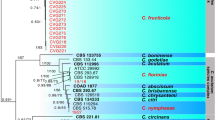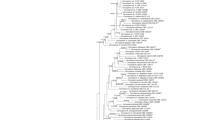Abstract
The aim of this study was to identify the Colletotrichum species associated with anthracnose symptoms in coffee (Coffea arabica L.) plantations in northern Puebla, Mexico. In 2013, five surveys were conducted in different production areas and at different altitudes. Symptomatic leaves, shoots, and ripe and unripe fruits of the coffee variety Red Caturra were collected. Isolates were obtained and the Colletotrichum species were identified morphologically and characterized by multilocus sequence analyses of the ACT, CAL, GAPDH, and TUB2 genes and the rDNA region. Additionally, pathogenicity tests were conducted using six isolates. We identified C. gigasporum, C. gloeosporioides, C. karstii (two isolates), C. siamense, and C. theobromicola. This is the first report of these five species infecting leaves of coffee. The symptoms caused by these species were characterized, but the species causing Coffee Berry Disease was not found. This is the first report of a complex of species affecting coffee plants in the same geographical area in Mexico, and suggests that other complexes of species may be important pathogens in coffee-producing areas elsewhere.



Similar content being viewed by others
References
Cannon, P. F., Buddie, A. G., & Bridge, P. D. (2008). The typification of Colletotrichum gloeosporioides. Mycotaxon, 104, 189–204.
Carbone, I., & Kohn, L. M. (1999). A method for designing primer sets for speciation studies in filamentous ascomycetes. Mycologia, 91, 553–556.
Castellanos, G., Jara, C., & Mosquera, G. (2013). Producción de micelio en medio líquido para extracción de ADN. CIAT. Centro Internacional de Agricultura Tropical (Mycelium production in liquid medium for DNA extraction. CIAT. International Center of Tropical Agriculture). http://ciat.cgiar.org/wp-content/uploads/2013/04/guia_practica9.pdf. Accessed 15 February 2015.
CNC (1952). Comisión Nacional del Café. Manual Práctico del Cultivo de Cafeto en México (Practical Handbook of Coffee Cultivars in Mexico). Mexico.
Crous, P. W., Verkley, G. J. M., Groenewald, J. Z., & Samson, R. A. (Eds.). (2009). Fungal Biodiversity. CBS, Laboratory Manual Series. Utrecht: CBS-KNAW Fungal Biodiversity Centre.
Damm, U., Cannon, P. F., & Crous, P. W. (Eds.) (2012a). Colletotrichum: complex species or species complexes? Studies in Mycology, 73, 1–215.
Damm, U., Cannon, P. F., Woudenberg, J. H. C., & Crous, P. W. (2012b). The Colletotrichum acutatum species complex. Studies in Mycology, 73, 37–114.
Damm, U., Cannon, P. F., Woudenberg, J. H. C., Johnston, P. R., Weir, B. S., Tan, Y. P., Shivas, R. G., & Crous, P. W. (2012c). The Colletotrichum boninense species complex. Studies in Mycology, 73, 1–36.
DNASTAR (2001). Lasergene expert sequence analysis software, User manual. Version 5. Wisconsin, USA: DNASTAR Inc. Madison.
Doyle, V. P., Oudemans, P. V., Rehner, S. A., & Litt, A. (2013). Habitat and host indicate lineage identity in Colletotrichum gloeosporioides s.l. from wild and agricultural landscapes in North America. PLoS One, 8(5), e62394. doi:10.1371/journal.pone.0062394.
Evangelista, O. V. J., López, B. J., Caballero, N. J., & Martínez, A. M. A. (2010). Patrones espaciales de cambio de cobertura y uso del suelo en el área cafetalera de la sierra norte de Puebla (Spatial patterns of change in coverage and land use in the coffee area of the mountains of northern Puebla). Investigaciones Geográficas. Boletín del Instituto de Geografía. Universidad Nacional Autónoma de México. UNAM. Mexico, 72, 23–38. http://www.redalyc.org/articulo.oa?id=56919174003. Accessed 4 May 2015.
FAOSTAT (2013). Food and Agriculture Organization of the United Nations Statistics .http://faostat.fao.org/. Accessed 12 February 2016.
Gardes, M., & Bruns, T. D. (1993). ITS primers with enhanced specificity for basidiomycetes application to the identification of mycorrhizae and rusts. Molecular Ecology, 2, 113–118.
Glass, N. L., & Donaldson, G. (1995). Development of primer sets designed for use with PCR to amplify conserved genes from filamentous ascomycetes. Applied and Environmental Microbiology, 61, 1323–1330.
Köppen, W. (1936). Das Geographische System der Klimate. In W. Köppen & R. Geiger (Eds.), Handbuch der Klimatologie. Bd., I, Teil C. Balul I, Teil C. Berlin: Verlag von Gebrüder Borntl’aeger. http://koeppen-geiger.vu-wien.ac.at/pdf/Koppen_1936.pdf. Accessed 7 Jul 2016.
Liu, F., Damm, U., Cai, L., & Crous, P. (2013). Species of the Colletotrichum gloeosporioides complex associated with anthracnose diseases of Proteaceae. Fungal Diversity, 61, 89–105.
Liu, F., Cai, L., Crous, P. W., & Damm, U. (2014). The Colletotrichum gigasporum species complex. Persoonia, 33, 83–97.
Nelson, S. C. (2008). Cercospora leaf spot and berry blotch of coffee. USA: Department of Plant and Environmental Protection Sciences Plant Disease. College of Tropical Agriculture and Human Resource. Cooperative Extension Service. University of Hawai'i at Manoa http://www.ctahr.hawaii.edu/oc/freepubs/pdf/PD-41.pdf. Accessed 23 February 2015.
Nguyen, P. T. H., Pettersson, O. V., Olsson, P., & Liljeroth, E. (2010). Identification of Colletotrichum species associated with anthracnose disease of coffee in Vietnam. European Journal of Plant Pathology, 127, 73–87.
Omondi, C. O., Ayiecho, P. O., Mwang'Ombe, A. W., & Hindorf, H. (2000). Reaction of some Coffea arabica genotypes to strains of Colletotrichum kahawae, the cause of coffee berry disease. Journal of Phytopathology, 148, 61–63.
Pinkert, C. J. (2004). Nutrient and quality analysis of coffee cherries in Huong Hoa district, Vietnam (No. 280, p. 47). Plant Research International.
Prihastuti, H., Cai, L., Chen, H., McKenzie, E. H. C., & Hyde, K. D. (2009). Characterization of Colletotrichum species associated with coffee berries in northern Thailand. Fungal Diversity, 39, 89–109.
Rakotoniriana, E. F., Scauflaire, J., Rabemanantsoa, C., Urveg-Ratsimamanga, S., Corbisier, A. M., Quetin-Leclercq, J., Declerck, S., & Munaut, F. (2013). Colletotrichum gigasporum sp. nov., a new species of Colletotrichum producing long straight conidia. Mycological Progress, 12, 403–412.
Rojas, E. I., Rehner, S. A., Samuels, G. J., Van Bael, S. A., Herre, E. A., Cannon, P. F., Chen, R., Pang, J., Wang, R., Zhang, Y. Q., & Sha, T. (2010). Colletotrichum gloeosporioides s.l. associated with Theobroma cacao and other plants in Panama: multilocus phylogenies distinguish pathogen and endophyte clades. Mycologia, 102, 1318–1338.
Ronquist, F., & Huelsenbeck, J. P. (2003). MrBayes 3: Bayesian phylogenetic inference under mixed models. Bioinformatics Applications Note, 19, 1572–1574.
Sequencher (2014). Sequence analysis software Version 5.3. Ann Arbor, MI, USA: Gene Codes Corporation.
Sharma, G., & Shenoy, B. D. (2013). Multigene sequence-based identification of Colletotrichum cymbidiicola, C. karstii and C. phyllanthi from India. Czech Mycology, 65, 79–88.
SIAP (2014). Servicio de información agroalimentaria y pesquera. Cierre de la producción agrícola por estado (SIAP. Agrifood and Fisheries Information Service. Agricultural production by state). http://www.siap.gob.mx/cierre-de-la-produccion-agricola-por-estado/. Accessed 10 Feb 2015.
Silva, D. N., Várzea, V., Cai, L., Salgueiro, P. O., & Batista, D. (2012). Application of the Apn2/MAT locus to improve the systematics of the Colletotrichum gloeosporioides complex: an example from coffee (Coffea spp.) hosts. Mycologia, 104, 396–409.
Sutton, B. C. (1980). The Coelomycetes. Fungi imperfecti with pycnidia, acervuli and stromata. Kew, Surrey, England: Commonwealth Mycological Institute.
Tamura, K., Stecher, G., Peterson, D., Filipski, A., & Kumar, S. (2013). MEGA6: Molecular Evolutionary Genetics Analysis Version 6.0. Molecular Biology and Evolution, 30, 2725–2729.
Waller, J. M., Bridge, P. D., Black, B., & Hakiza, G. (1993). Characterization of the coffee berry disease pathogen, Colletotrichum kahawae sp. nov. Mycological Research, 97, 989–994.
Weir, B. S., Johnston, P. R., & Damm, U. (2012). The Colletotrichum gloeosporioides species complex. Studies in Mycology, 73, 115–180.
White, T. J., Bruns, T., Lee, S., & Taylor, J. (1990). Amplification and direct sequencing of fungal ribosomal RNA genes for phylogenetics. In M. A. Innis, D. H. Gelfand, J. J. Sninsky, & T. J. White (Eds.), PCR Protocols: a guide to methods and applications. San Diego: Academic Press.
Woudenberg, J. H. C., Aveskamp, M. M., Gruyter, J. de, Spiers, A. G., & Crous, P. W. (2009). Multiple Didymella teleomorphs are linked to the Phoma clematidina morphotype. Persoonia, 22, 56–62.
Youlian, Y., Cai, L., Yu, Z., Liu, Z., & Hyde, K. D. (2011). Colletotrichum species on Orchidaceae in southwest China. Cryptogamie, Mycologie, 32, 229–253.
Acknowledgments
The authors wish to thank the National Council for Science and Technology (CONACYT) in Mexico for support (grant no. 1131132). The authors also thank the following farmers in Puebla State: Evaristo López Lugo, Rufino Vargas Castillo, and Sostenes Olivares S., for allowing us to collect coffee tree samples.
Author information
Authors and Affiliations
Corresponding author
Ethics declarations
Conflict of interest
The authors declare that they have no conflict of interest.
Rights and permissions
About this article
Cite this article
Cristóbal-Martínez, A.L., de Jesús Yáñez-Morales, M., Solano-Vidal, R. et al. Diversity of Colletotrichum species in coffee (Coffea arabica) plantations in Mexico. Eur J Plant Pathol 147, 605–614 (2017). https://doi.org/10.1007/s10658-016-1029-0
Accepted:
Published:
Issue Date:
DOI: https://doi.org/10.1007/s10658-016-1029-0




